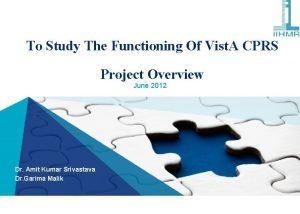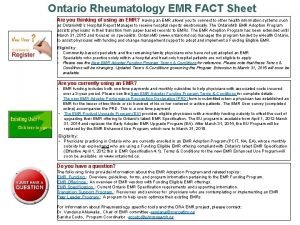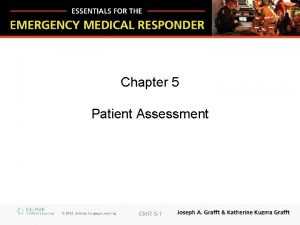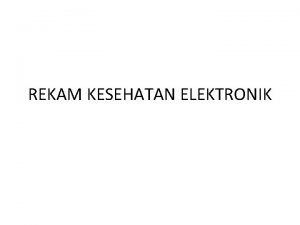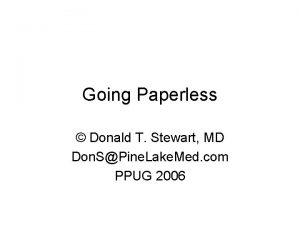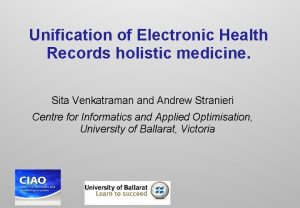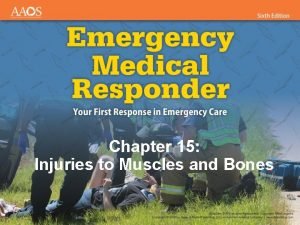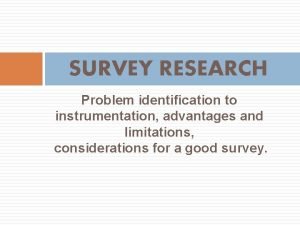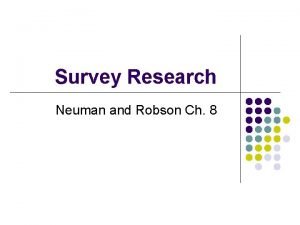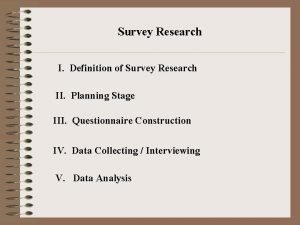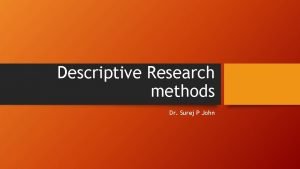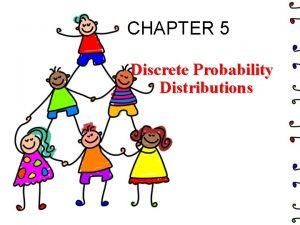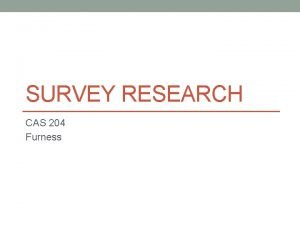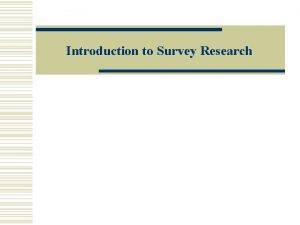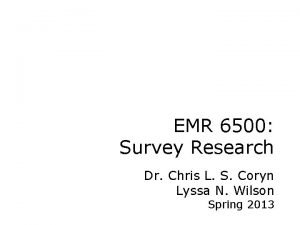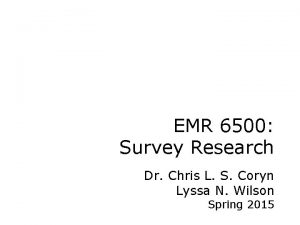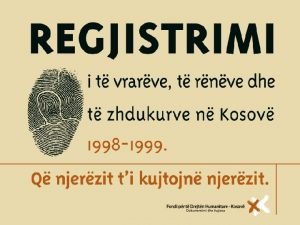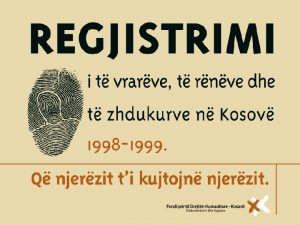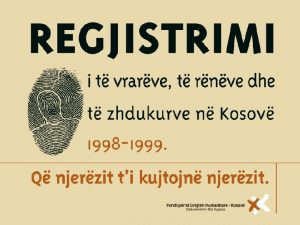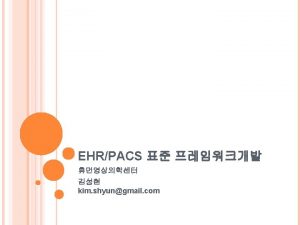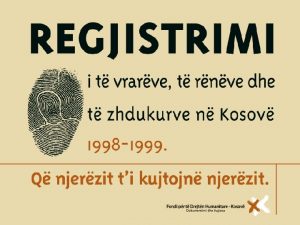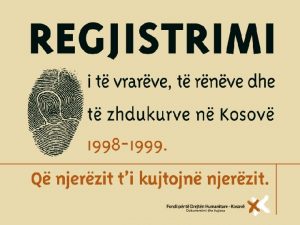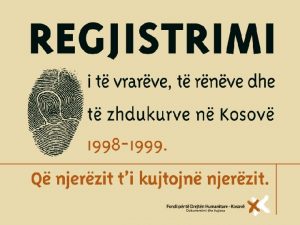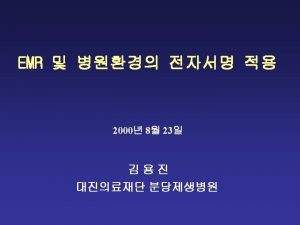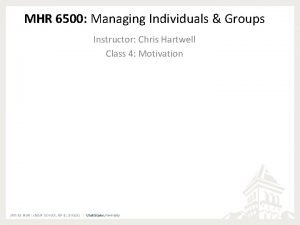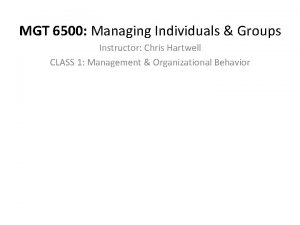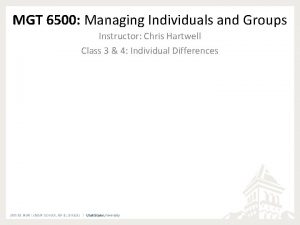EMR 6500 Survey Research Dr Chris L S











































- Slides: 43

EMR 6500: Survey Research Dr. Chris L. S. Coryn Lyssa N. Wilson Spring 2015

Agenda • • • Simple random sampling Crafting good questions Midterm examination Case Study #1 Case Study #2

Simple Random Sampling

Simple Random Sample • Recall that a simple random sample is a sample of n elements from a population of N in which each possible sample of size n has the same probability of selection, namely • The probability of any element being selected is equal to the ratio of the sample size to the population size

Estimation of a Population Mean and Total

Estimate of Population Mean

Example for a Population Mean • If n = 200 was selected from N = 1, 000 and the sample mean was = 94. 22 with a sample variance of = 445. 21, the bound on the error of estimation, B, would be

Estimate of Population Total

Example for a Population Total • If n = 50 was selected from N = 750 and the sample mean was = 10. 31 ( = 750(10. 31) = 7, 732. 5) with a sample variance of = 2. 25, the bound on the error of estimation, B, would be

Selecting the Sample Size for Estimating Population Means and Totals

Sample Size for Estimating Population Means • where

Sample Size for Estimating Population Means • Often, the population variance, , is unknown • An approximate value of can be obtained by

Example for a Population Mean • If N = 1, 000 and the estimated range is 100, the sample size necessary to estimate with B = 3 would be • and

Example for a Population Mean • If • where • then

Sample Size for Estimating Population Totals • where

Sample Size for Estimating Population Totals • If N = 1, 000 and = 36. 00, the sample size necessary to estimate the population total, , with B = 1, 000 would be • then

Estimation of a Population Proportion

Estimate of Population Proportion where

Example for a Population Proportion • If n = 100 was selected from N = 300 and the sample proportion was = 0. 15 the bound on the error of estimation, B, would be

Selecting the Sample Size for Estimating a Population Proportion

Sample Size for Estimating Population Proportions • where • and

Example for a Population Proportion • If N = 2, 000 and the desired bound on the error of estimation, B, were 0. 05, and no prior information is available to estimate , the necessary sample size would be

Example for a Population Proportion • Then

An Overview of Crafting Good Questions

Issues to Consider 1. What survey mode(s) will be used to ask the questions? 2. Is the question being repeated from another survey, and/or will answers be compared to previously collected data? 3. Will respondents be willing and motivated to answer accurately? 4. What type of information is the question asking for?

Choosing Words and Forming Question 1. 2. 3. 4. 5. 6. 7. 8. 9. Make sure the question applies to the respondent Make sure the question is technically accurate Ask one question at a time Use simple and familiar words Use specific and concrete words to specify the concepts clearly Use as few words as possible to pose the question Use complete sentences with simple sentence structures Make sure “yes” means yes and “no” means no Be sure the question specifies the response task

Visual Presentation of Survey Questions 1. 2. 3. 4. 5. 6. 7. 8. 9. Use darker and/or larger print for the question and lighter and/or smaller print for answer choices and answer spaces Use spacing to create subgrouping within a question Visually standardize all answer spaces or response options Use visual design properties to emphasize elements that are important to the respondent and to deemphasize those that are not Make sure words and visual elements that make up the question send consistent messages Integrate special instructions into the question where they will be used rather than including them as freestanding entities Separate optional or occasionally needed instructions from the question stem by font or symbol variation Organize each question in a way that minimizes the need to reread portions in order to comprehend the response task Choose line spacing, font, and text size to ensure the legibility of the text

Additional Considerations • Abilities/aptitudes – Knowledge or skill • Attitudes – General and enduring evaluation of a person, object, or concept • Behaviors – Actions and mannerisms • Opinions/beliefs – Subjective beliefs that occur as a result of emotion or interpretation of facts

Closed-Ended Nominal Questions

Closed-Ended Ordinal Questions

Closed-Ended Ordinal Questions

Semantic Differentials

Visual Analogs

Guttman Scaling • Individuals who endorse the first response should also endorse all others as they represent less extreme views

Partially Closed

Open-Ended Questions

Filters/Skip Patterns

Midterm Examination

Midterm Examination • The examination will consist of 50 -75 multiple-choice items, scored as 0 or 1 • You will have 2½ hours to complete the examination • You may use one page of notes (front and back) on 8½” X 11’’ paper – You will be required to determine necessary sample sizes and calculate bounds on the error of estimation for means, totals, and proportions • You may use a calculator or an Excel spreadsheet on a laptop computer • You cannot use the internet or textbooks

Case Study #1

Case Study Activity 1. Write a focal question that addresses what proportion of foundations formally assess the effectiveness of their grant making activities 2. Determine the motivational features that you would use to encourage high quantity and quality of responses, with particular attention to: – – – How the perceived rewards for responding would be increased How the perceived costs of responding would be reduced How trust would be established so that people believe the rewards will outweigh the costs of responding 3. Determine the necessary sample size to estimate the population proportion, p, of foundations (N = 888) to address your focal question with a bound on the error of estimation of B = 0. 05 and B = 0. 10

Case Study #2

Case Study Activity • Consider the guidelines for “choosing words and framing questions” and “visual presentation of survey questions” 1. Are there any errors associated with the guidelines for choosing words and framing questions? 2. Are there any errors associated with the guidelines of the visual presentation of survey questions?
 Toon blast 6500
Toon blast 6500 Ing ulb
Ing ulb My ciena learning
My ciena learning Silicone logo
Silicone logo Emerson a6740
Emerson a6740 Acls secondary survey
Acls secondary survey Cprs emr system
Cprs emr system Star tsp800rx thermal prescription printer
Star tsp800rx thermal prescription printer Rheumatology emr software
Rheumatology emr software Nextgen electronic medical record
Nextgen electronic medical record Emr normalized instance hours
Emr normalized instance hours Emr data mining
Emr data mining Emr patient assessment
Emr patient assessment As an emr, your two primary extrication goals include:
As an emr, your two primary extrication goals include: Aws sqs queue icon
Aws sqs queue icon Rekam kesehatan elektronik adalah
Rekam kesehatan elektronik adalah Myhealth
Myhealth 10000000/27000
10000000/27000 Orchestra one emr
Orchestra one emr Ritefax
Ritefax Pathology emr
Pathology emr Mysis emr
Mysis emr Emr ehr phr
Emr ehr phr Holistic medicine emr
Holistic medicine emr Tribal health emr
Tribal health emr Tribal health emr
Tribal health emr Electromagnetic spectra
Electromagnetic spectra Open receivables
Open receivables Rpms ihs
Rpms ihs Indian health ehr
Indian health ehr Injuries to muscles and bones chapter 15
Injuries to muscles and bones chapter 15 Aws sns icon
Aws sns icon What is the sample size in qualitative research?
What is the sample size in qualitative research? Strengths of survey
Strengths of survey Survey definition in research
Survey definition in research Descriptive survey
Descriptive survey Advantages of descriptive research
Advantages of descriptive research Advantages of survey research
Advantages of survey research A survey from teenage research unlimited found
A survey from teenage research unlimited found Literature review
Literature review Descriptive survey research design
Descriptive survey research design Survey research advantages and disadvantages
Survey research advantages and disadvantages Steps in survey research
Steps in survey research Experience survey in exploratory research
Experience survey in exploratory research






